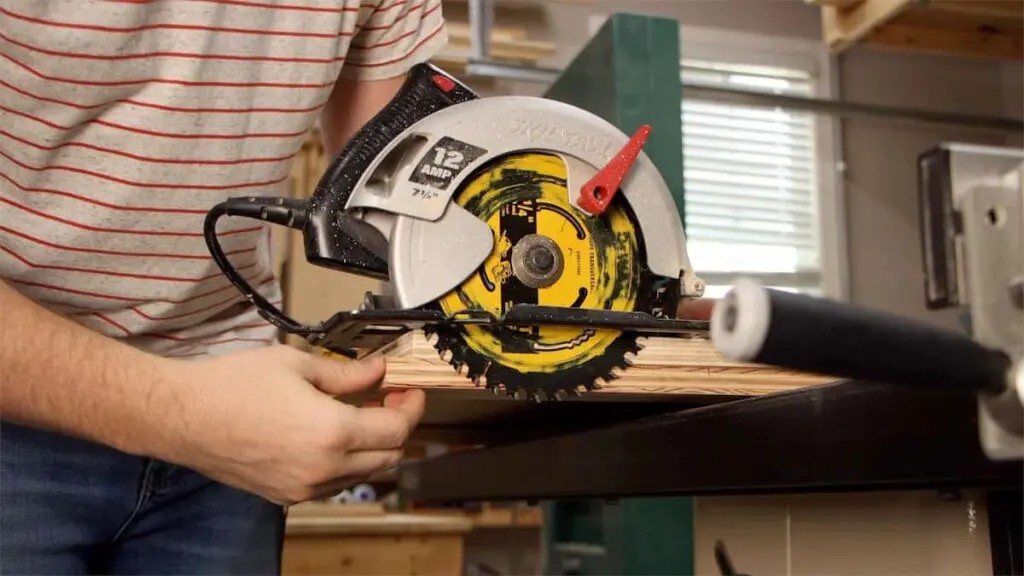Breaking down sheet goods like plywood can be challenging for woodworkers. While a table saw might seem like an option, it often requires two people and can still be awkward. Using a circular saw with a straight edge is a more manageable solution. This guide will show you How To Make A Circular Saw Guide for accurate and repeatable cuts, as well as discuss alternative options and their limitations.
Existing clamping straight edges can be useful, but they require accounting for both the desired measurement and the distance from the circular saw blade to the edge of its base. This introduces an extra step and potential for error. Similarly, retrofit products that convert your circular saw into a track saw can have issues with fit and slop, leading to uneven cuts and difficulties in alignment over time.
Considerations Before Building Your Circular Saw Guide
Before diving into the construction process, consider these crucial factors:
(1) Saw Clearance: Ensure adequate clearance for the saw motor and any protruding parts above the fence at your desired cutting depth. Lower the saw until it nearly touches the fence, then raise it slightly to provide sufficient space. This determines your minimum cutting depth. Subsequently, place a piece of stock under the fence and confirm that the blade can cut entirely through it.
(2) Straight Edge Selection: Achieving a perfectly straight fence is essential. You can either have your plywood pre-cut at a home center using their panel saw or, as demonstrated in the video, utilize the factory edge of the plywood. Carefully inspect each edge and select the straightest one.
(3) Starting Width: The cutting side of the jig should initially be wider than the saw base. This provides enough material for making a precise, zero-clearance cut in the final step.
(4) Clamping Space: The opposite side of the jig needs to be wide enough to accommodate clamps since you cannot clamp directly onto the fence or cutting side. Aim for a width of approximately 6 inches from the fence to the edge of the jig.
Step-by-Step Guide: Building Your Circular Saw Guide
Here’s how to construct your own circular saw guide:
-
Initial Cut: Using the straightest factory edge you’ve identified, measure 3 inches inward and make a freehand cut.
-
Fence Placement: Position the saw on the jig. Flip the fence over so the factory edge faces right. Align the factory edge with the edge of the saw base. Mark the location of the fence on each side of the jig. Measure 6 inches from the right side of the fence to the right side of the jig and make a mark at each end.
-
Jig Cutout: Using your circular saw, freehand cut along the marked lines to shape the jig.
-
Fence Attachment: Apply glue to the fence and secure it to the jig using screws, brad nails, or clamps. Ensure the fence remains tight against the jig until the glue is fully dry. The fence doesn’t need to be perfectly parallel to the jig’s edge, as long as the saw has enough room to make a clean cut.
-
Zero Clearance Cut: With the fence securely attached, run your circular saw along the fence, maintaining even and consistent pressure. This creates a zero-clearance cut, ensuring accurate and splinter-free results.
Testing and Usage
-
Test Cut: Once the jig is complete, perform a test cut. Measure and mark the piece you intend to cut, then align the jig with the marks.
-
Clamp and Cut: Secure the jig to the workpiece using clamps. Run the circular saw along the guide, maintaining even pressure against the fence for a straight and accurate cut.
While an 8-foot guide might be useful in some scenarios, a 4-foot guide offers greater versatility for both crosscuts and shorter rip cuts. This size is often more practical for general woodworking projects.
Creating your own circular saw guide is a cost-effective and efficient way to improve the accuracy and ease of cutting sheet goods. By following these steps and considering the key factors, you can build a reliable jig that will enhance your woodworking projects for years to come.
